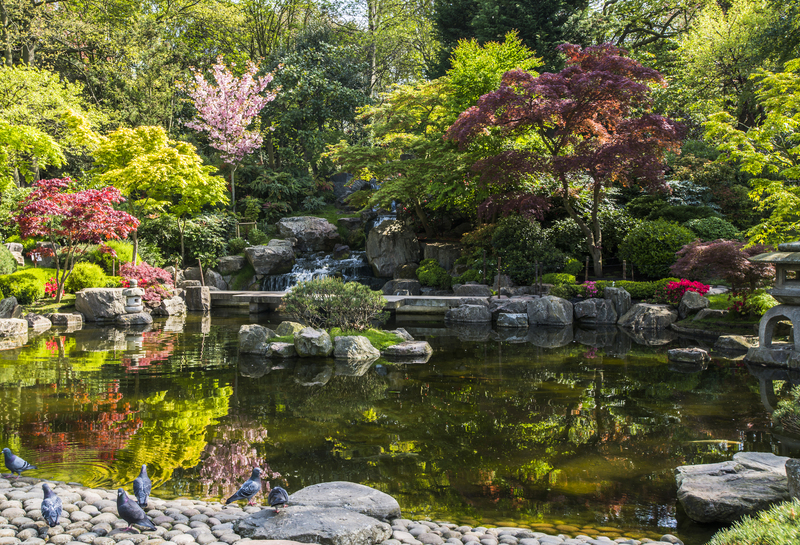Hedge Trimming: Achieving Artistic Garden Shapes
Posted on 14/08/2025
Hedge Trimming: Achieving Artistic Garden Shapes
If you are passionate about gardening, hedge trimming is both a skill and an art that can dramatically enhance the visual appeal of your outdoor space. By expertly sculpting hedges, you can achieve intricate garden designs, create privacy, and even show off your creative flair with artistic shapes. This comprehensive guide will provide in-depth advice on achieving artistic garden shapes through hedge trimming, offering useful tips, techniques, and inspiration for both beginners and experienced gardeners.
Why Artistic Hedge Trimming Matters
Garden hedges aren't just practical barriers; they serve as living sculptures that add structure and character to any landscape. With expert hedge shaping, you can turn an ordinary green mass into a stunning focal point--whether it's a series of perfect spheres, elaborate spirals, or whimsical animal shapes.
- Increased Property Value: Well-maintained, artistically shaped hedges can boost curb appeal and ultimately, your property's value.
- Personal Expression: Topiary art allows you to put your personal stamp on your garden.
- Landscape Structure: Define spaces, create outdoor rooms, and guide the eye with strategically trimmed hedges.

Understanding the Basics of Hedge Trimming and Shaping
_Hedge trimming_ is about more than just keeping your plants tidy. It involves understanding plant growth patterns, choosing the right tools, and applying key principles to achieve creative and healthy results.
Key Principles of Artistic Hedge Shaping
- Patience: Artistic shapes take time to develop. Regular but careful trimming promotes dense growth and precise forms.
- Plant Health: Never sacrifice the health of your hedge for art. Always follow best horticultural practices.
- Symmetry and Proportion: Balanced shapes are aesthetically pleasing; use guides or frames for accuracy.
Choosing the Right Plants for Artistic Hedge Forms
Selecting suitable hedge species is critical for achieving crisp, long-lasting shapes. Plants with small leaves, dense growth, and good regenerative ability respond best to topiary and creative shaping.
Top Choices for Artistic Hedge Trimming
- Buxus sempervirens (Common Boxwood): The classic topiary hedge; grows slowly, responds well to clipping.
- Taxus baccata (English Yew): Long-lived, tolerates deep shade, can be trimmed to intricate designs.
- Ligustrum (Privet): Fast-growing and very responsive to shaping, great for bold forms.
- Ilex crenata (Japanese Holly): A good alternative to boxwood; produces neat, fine-textured hedges.
- Euonymus (Spindle): Offers colorful foliage for artistic contrasts.
*Other species, such as Lonicera nitida, Berberis, and Viburnum, are also suitable for varied climates and effects.
Essential Tools for Shaping Hedges Creatively
To unlock your garden's artistic potential, you'll need the right tools for precise hedge trimming and creative shaping.
- Manual Hedge Shears: Offer control for detailed work and finishing touches.
- Powered Hedge Trimmers: Great for large, straight stretches but use caution on curves and intricate details.
- Topiary Frames and Templates: Metal or wire guides shape complex designs, especially for beginners.
- Pruning Secateurs: For snipping stubborn twigs or refining small details.
- Measuring Tape and String: Ensure symmetry and evenness across your hedge masterpiece.
Maintenance and Safety Tips
- Sharp Blades: Clean and sharpen regularly for healthy cuts.
- Protective Gear: Use gloves and safety glasses to protect hands and eyes from debris.
- Regular Cleaning: Remove clippings from the hedge to prevent disease.
Step-by-Step: Achieving Artistic Hedge Shapes
Ready to embrace the world of creative hedge shaping? Here's a roadmap for transforming your hedges into living works of art.
Step 1: Choose Your Design
Begin with a vision. Browse gardening books, visit public gardens, or sketch your own design. Common artistic hedge shapes include:
- Geometric Forms (spheres, cubes, cones, pyramids)
- Spirals and Waves
- Archways and Tunnels
- Animal Figures (topiary art)
- Letters and Patterns
Use topiary frames for complex shapes or freehand for simpler forms. Always consider your hedge's maturity--older, larger plants offer more shaping options.
Step 2: Mark Out the Structure
Define the outline with canes, string, or chalk. For symmetrical designs, measure carefully on both sides.
Step 3: Start Trimming
- Begin with Coarse Cuts: Use shears or powered trimmers to roughly shape the form, removing large excess growth.
- Refine the Shape: Switch to hand shears for detailed, precise work. Stand back frequently to check symmetry and proportion.
- Final Touches: Prune out any straggly twigs and smooth out bumps for a sleek finish.
Step 4: Maintain the Artistry
Regular trimming (two to three times a year for most formal styles) is essential to maintain shape and encourage dense, lush foliage. Some topiary forms require monthly touch-ups, especially during rapid growth in spring and early summer.
Expert Techniques for Stunning Hedge Designs
Take your craft beyond the basics with these advanced hedge-trimming techniques and professional secrets for flawless artistry:
Mastering Perspective and Scale
- Wider Base, Narrower Top: Always keep the base slightly wider than the top. This ensures lower branches get enough sunlight, preventing bare patches.
- Tapered Sides: Subtle tapering helps water run off and supports lush, even growth.
Symmetry Tricks
- Use Poles and String: For long stretches or mirrored shapes, set up a visual guide for perfectly straight lines and balanced curves.
- Step Back Often: Move around and view your work from different angles to spot inconsistencies.
Special Effects in Hedge Sculpting
- Layered Hedges: Create depth with stacked shapes or staggered heights.
- Color Contrasts: Interplant variegated or colorful species for vibrant, eye-catching art.
- Espalier and Living Fences: Train plants along fences or walls for flat, intricate patterns.
Caring for Shaped Hedges Year-Round
Healthy plants are the foundation for vibrant and artistic hedge trimming. Follow these care guidelines for topiary success:
Water and Feeding
- Consistent Watering: Especially important after heavy trims and during hot, dry periods.
- Balanced Fertilizer: Use a slow-release fertilizer in spring to encourage dense, green foliage.
Pest and Disease Management
- Monitor Regularly: Check for pests like boxwood caterpillar, aphids, or scale insects.
- Prompt Action: Treat issues quickly with organic or appropriate chemical controls.
Rejuvenating Overgrown or Damaged Hedges
- Hard Pruning: For tired hedges, a severe cut-back in late winter can spark dense regrowth. Only attempt if your species tolerates this.
- Reshaping: Gradually return neglected plants to formal shapes over one to three seasons.
Common Mistakes in Artistic Hedge Trimming (And How to Avoid Them)
Even seasoned gardeners can slip up. Be mindful of these frequent errors:
- Trimming at the Wrong Time: Avoid cutting hedges during extreme heat, severe cold, or nesting bird season.
- Over-Pruning: Removing too much at once can stress and weaken plants. Shape gradually for best results.
- Neglecting Tools: Dull blades crush stems, inviting disease. Clean and sharpen after each use.
- Poor Planning: Attempting complex designs without adequate research often leads to disappointment. Start simple and build skills over time.
Inspiration: Iconic Examples of Artistic Hedge Shaping
For centuries, majestic gardens around the world have showcased the wonders of topiary and creative hedge trimming:
- Levens Hall, England: Features ancient yew and boxwood topiaries in stunning, imaginative forms.
- Chateau de Villandry, France: Renowned for elaborate ornamental parterres and clipped box hedges.
- Ladew Topiary Gardens, USA: Home to whimsical animal and hunt scene shapes sculpted from living hedges.
Visit these sites or find local public gardens for further ideas and a burst of creative motivation!
Frequently Asked Questions About Artistic Hedge Trimming
How often should I trim my shaped hedges?
Most formal hedges benefit from two to three trims per year, concentrating on spring and late summer. Fast-growing species or intricate designs may need more frequent attention.
What is the best time of year to shape hedges?
Late spring or early summer is ideal for major shaping, as new growth recovers quickly. Avoid trimming during freezing weather or extreme heat.
Can any hedge be shaped into artwork?
While many species can be pruned, those with fine leaves, dense branching, and vigorous regrowth (like boxwood or yew) are best for intricate/topiary work. Some fast-growing hedges are better for bold, large-scale designs.
How do I fix mistakes or accidental over-trimming?
Be patient and let your hedge regrow--it may take a season or two. Fertilize lightly and water well. Apply gradual shaping in subsequent trims.

Conclusion: Realizing Your Garden's Artistic Potential
Achieving artistic garden shapes through hedge trimming is a fulfilling pursuit, blending horticultural wisdom with creative expression. By mastering hedge trimming techniques, understanding plant selection, and nurturing your artistry, you can transform your garden into a living gallery that delights and inspires year-round.
Begin with simple geometric designs and progress to more elaborate forms as your confidence grows. Observe, practice, and experiment--remember that every master pruner was once a beginner. With time, patience, and the tips shared here, your garden hedges will become the envy of your neighborhood.
Ready to start your creative hedge trimming journey? Grab your shears, plan your first design, and enjoy the satisfying art of sculpting nature's green canvas!
Related Resources
- RHS: Trimming formal hedges
- BBC Gardening: Pruning hedges
- Garden Design: How to Plant and Trim Hedges
Whether you seek privacy, structure, or a canvas for your creativity, artistic hedge trimming unlocks endless possibilities in your garden. Happy sculpting!

